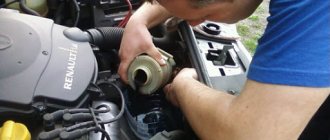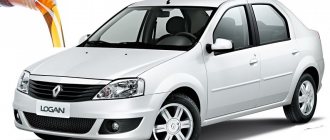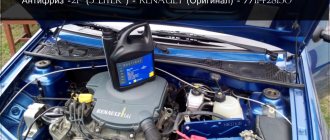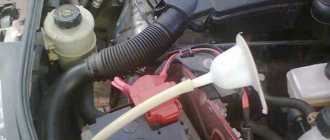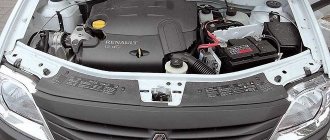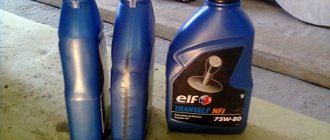During the operation of the Renault Logan power steering, the fluid in it gradually darkens, its physical and chemical characteristics change for the worse. There comes a time when it is necessary to replace it so that the collected debris does not damage the power steering components. Changing the oil in the Renault Logan power steering is a simple operation that you can do yourself if you know the sequence of actions.
Is oil so important in power steering?
The hydraulic booster is one of the most important control elements of a car.
The degree of controllability of the car directly depends on its functioning. If you do not monitor the condition of this unit, then in an emergency the power steering efforts will not be enough to quickly turn the wheel and perform a maneuver. This could result in a serious traffic accident. The design of the unit includes a pump, distributor, hydraulic cylinder, connecting hoses, and a reservoir with working fluid. The latter is precisely the power steering oil. The main force is generated by the pump, but its work will be absolutely useless if the oil does not meet the necessary requirements and has already lost its performance qualities. In general, power steering oil performs a number of functions:
- Lubrication. Any moving parts must be lubricated. This minimizes friction, the formation of metal chips and extends the life of the unit.
- Temperature removal, which reduces the chance of overheating to almost zero.
- Power steering oil in Renault Logan protects structural elements from corrosion. The composition forms a thin protective film on the surface that prevents oxidation of the metal.
Thus, power steering operation is impossible without oil, so if there are leaks, they must be repaired urgently. Outdated oil requires replacement, otherwise problems may arise with the amplifier. A breakdown of the pump or other components of the unit will require expensive replacement. Additionally, correct operation of the amplifier extends the life of the steering rack itself, so drivers will have to call for repairs less often.
Types of power steering for Renault Logan
Cars are equipped with the following types of hydraulic boosters:
- Power steering with electric pump. The principle of operation of the mechanism is that the lubricating fluid is pumped through a pump. It, in turn, operates thanks to a car generator. The hydraulic “electric booster” operates in certain phases. It is expensive to operate and maintain, and is usually installed on expensive cars.
- Power steering MSV with belt pump. Renaut Logan cars with an engine capacity of 4 and 1.6 liters for 75 and 87 hp. are equipped with just such a mechanism that facilitates the rotation of the steering wheel. The belt wears out over time, but installing a new one is not difficult.
As for the pump itself, a classic device is installed on Logan. It has proven itself well, thanks to stable operation and rare breakdowns.
Replacement Regulations
Drivers have virtually no questions when replacing the main working fluids (engine oil or coolant). However, not all owners know when to change the power steering oil in Renault Logan. Here it is worth referring to the technical manual of your vehicle. The manufacturer advises changing the hydraulic booster oil every 40 thousand kilometers. This is true for models released in the last 5-8 years. If we talk about older Renault Logan, then a new composition should be filled in every 25-30 thousand kilometers.
When buying a used car, drivers are advised to change the oil immediately. It is unknown how long the old composition has been in use. If the machine is idle for more than 1 year, it should also be replaced. Naturally, if the fluid level in the tank is low, it is recommended to top up with a compatible one or fill in a completely new composition.
How to choose a pump and change the belt?
The power steering belt also needs to be replaced. The automaker does not give an exact answer to the question of how long it needs to be changed, but experienced drivers recommend a figure of 100–150 thousand kilometers. In addition, the belt and oil are replaced if the power steering starts to hum. The occurrence of extraneous noise in the operation of the car always indicates a malfunction.
Currently reading: Power steering fluid for Renault Logan - renaultmatic d2 analogue
In some cases, the problem lies in the pump, and a more rational solution would be to purchase a new part. When choosing a pump, you need to take into account the manufacturer and article number to avoid counterfeiting. For example, for Renault Logan, pumps with codes 491100699R and 7700435692 from Francecar are recommended. After replacing the part and adding new oil, the extraneous sounds in the power steering will disappear.
To replace the belt you will need a key “14”.
The operation is carried out in five steps:
- The fastening elements of the power steering pump are loosened.
- The adjusting bolt is unscrewed, the specification of which is the level of belt tension.
- When the belt is loosened, you can begin to remove it from the pulleys of the power steering pump, air conditioning and crankshaft of the vehicle.
- Installation is carried out in reverse order.
- Finally, the tension level of the belt, which is located in the power steering pump, is adjusted.
After replacing the pump or belt, the power steering continues to function normally, and the oil pressure in the power steering remains at a stable level necessary for the operation of the entire power steering system.
Signs you need an oil change
Kilometers are only a guideline that you should use when analyzing the condition of any working fluids. It is much more useful to know the main symptoms that will help determine when the oil in the Renault Logan power steering is needed. This list includes:
- decrease in steering sensitivity, the wheel became more difficult to turn, with effort;
- Uncharacteristic sounds appeared in the area where the power steering was located;
- the oil level in the tank has dropped below the minimum mark;
- burning smells appeared in the area of the unit or from the fluid reservoir;
- manifestation of leaks;
- the appearance of foam in the expansion tank;
- small spontaneous turns of the steering wheel.
These symptoms indicate problems in the power steering system. In most cases, a simple oil change can eliminate them. At the same time, be prepared that one of the elements of the assembly (pump, rack, or other) could break.
You can also check the quality of the oil experimentally. It is necessary to drop a small amount of the composition from the tank onto a white piece of paper. If it is clearly dark in color with various small deposits, it means that the resource has come to the end of its life. Change the fluid ahead of schedule during repairs as soon as the fault is eliminated.
Replacing power steering fluid logbook Renault Logan LOGAN-BENZ 2009 on DRIVE2
Renault Logan Let's drive Logbook Replacing the lever and two stabilizer struts
MAY BE USEFUL FOR SOMEONE) After changing the oil in the gearbox with very noticeable results, the thought came to me about replacing the fluid in the hydraulic fluid. After reading, I realized that it changes either when the color changes, or once every 5 years, as its shelf life is just 5 years. In my case, both criteria are met) So, in brief and with pictures
We have a car like this)
yes, it wouldn't hurt to wash)
And here's a hydraulic tank
We cut off the top of a 5 liter bottle from the blue non-freezing muck and push it under the tank and radiator hose, it fits well there)
The tank can be easily removed from its mounts by moving upwards
Next, we take off the hoses one at a time, I first took off the thicker one. By the way, the hoses stick quite a bit, but there is one secret for removing them: use a thin flat screwdriver to pry up the edge and push the screwdriver 1/2 the length of the hose seat so that a little oil comes out and turn the hose, then it will come off without any problems. There are no problems with clamps; they are compressed with pliers without any problems) We drain the slurry from the tank, bend the hose under the pipe so that the slurry flows from it not onto the engine but into the jar
Next, I removed the thin one and sent both to the jar
Further DO NOT START! We make the car 3-4 full strokes (from lock to lock) of the rack, in short, until the slurry stops flowing from the hoses)
There was this strange substance in my system.
pink and doesn't smell
Next, we take the tank and, if you don’t have a garage like me, go home and rinse the tank, mesh filter and lid with warm water with fairy and dry it with a hairdryer
the mesh filter was half black, forgot to take a photo
We put the tank in place and connect the hoses
Now this is the cleanest part of the car)
This is what a fresh ATF looks like, by the way.
We fill the tank with liquid to the maximum and repeat the rotation of the steering wheel, WITHOUT STARTING THE CAR, as when draining, until the air bubbles in the tank stop gurgling. We add liquid to the maximum again and start the car, turn the steering wheel again from lock to lock 3 times. 4.Add the liquid again to a level between max and min. tighten the plug.
I got about 900 ml. total.
Maybe I did something wrong, but the slurry in the tank is clean, which means everything is OK IMHO))) Good luck to everyone on the roads! If you have any questions, write!
PS then I washed myself)))
Price: 300 ₽ Mileage: 104,000 km
www.drive2.ru
Types of oils
Before we talk about choosing a specific brand of oil, let's find out what types of this working fluid exist in principle. Manufacturers produce both special formulations that are intended for use in power steering systems and fluids compatible with gearboxes. There are two main types:
- Mineral. These compounds are used most often in systems with a large number of rubber parts (seals and the like). When exposed to high and low temperatures, rubber loses its quality. To prevent this, use mineral oil. It is gentle on rubber components and has a low cost. There are also a number of disadvantages: high viscosity, tendency to foam and short service life.
- Synthetic. Some of these oils have a destructive effect on rubber parts. Some manufacturers have improved the composition with silicone, which neutralized this effect. Synthetics have low viscosity, are durable, retain their qualities over a wide temperature range and are distinguished by better lubricating, anti-corrosion, and foam-suppressing properties. Naturally, you have to pay for this.
There is also a conditional classification of liquids by color. This is additional information. It is not absolute, since individual manufacturers may use dyes in their products. Most often, of course, the following colors are sold on the market:
- Red. Considered to be of the highest quality. They are made on the basis of synthetics. Similar compositions are also often used in automatic transmissions, but have a fairly narrow application specification.
- Yellow. As a rule, these are mineral oils, which are often used for gearboxes. An example is the products of the German company Daimler.
- Green. It is considered universal, but is used only in mechanics or only as a fluid for power steering. It has high viscosity. The base can be either mineral or synthetic.
Now you can visually determine the type of oil by color. Before pouring anything, be sure to study the specification, since the color of the liquid is not yet a 100% indicator.
Oil model
Now we can tell you what kind of oil to fill in the Renault Logan power steering. The optimal solution would be to purchase the original composition, which is poured into the tank at the factory. You will need Elf Renault Matic D2. The cost of production is 500-600 rubles. This oil is guaranteed to work properly in power steering without any problems. However, it is not always possible to find it. Drivers complain that supplies of this product to stores are too rare, even to official dealers.
No one forbids using an alternative if it is based on a synthetic or semi-synthetic base of the D2 ATF or PSF standard. You can use the following brands of oil:
- Elf Renault Matic G3;
- Mobil ATF 220 (320);
- Liqui Moly ATF 1100;
- Castrol ATF D2 (D3).
Please review each product's specifications first. For a complete change, you will need a Renault Logan power steering oil volume of 2 liters.
Be sure to study what the bottle of required oil looks like. The problem is that there are a lot of fakes on the market and even in some stores. Naturally, the quality of such a lubricant leaves much to be desired. To avoid falling for a fake, pay attention to the following:
- Container color. Counterfeits often have a different tone than the original products.
- The integrity of the cap, the absence of defects that would indicate that the bottle has been opened.
- Label. All inscriptions and drawings must be clear, without blurring or defects.
- The release date and batch number must be printed on the bottle.
- The label must provide comprehensive information on the oil.
We recommend ordering hydraulic fluids only from authorized dealers who have the appropriate certificates for authorization to sell.
Tips for using Renault power steering
Many drivers wipe the tank lid, as dust often settles on it. Adhering dust is not a sign of a fogging problem. It is strictly not recommended to do this.
The fact is that inside the cover there is a breather through which air escapes when the hydraulic booster is operating. The air is naturally oily.
When the driver wipes dust on the lid, some of it ends up in the tank, causing contamination of the system. Experienced drivers and craftsmen advise removing the lid and cleaning the lid valve and tank body at least once a year.
You should not hold the steering wheel in the extreme position for more than 10 seconds. This has a detrimental effect on the operation of the pump and quickly destroys the liquid. In this mode, the pressure in the system increases, squeezes out the seals, pipes and spoils the liquid, since under high pressure it begins to overheat.
Interesting on the topic: The latest Chinese. Review of Lifan MyWay 2018
Share with your friends!
- Click to share on Twitter (Opens in new window)
- Click here to share content on Facebook. (Opens in a new window)
- More
- Click to share on LinkedIn (Opens in new window)
- Click to share on Pinterest (Opens in new window)
- Click to share on Telegram (Opens in new window)
- Click to share on Skype (Opens in new window)
- Send this to a friend (Opens in new window)
Oil change procedure
Let's find out how to change the power steering oil on your Renault Logan. First, you will need to prepare the following tools: a 20 cc syringe with a suitable tube, a set of wrenches and socket wrenches, a 2-liter container for used oil. As a container, you can use a plastic bottle or a scrap of 5-liter eggplant. It is also recommended to perform these operations with an assistant, since replacement involves performing several actions simultaneously, which will be extremely difficult to do alone.
Having prepared the necessary tools, get to work:
- Open the hood. There you will find a tank containing lubricant for the system. Access is blocked by the ventilation system pipe. To move it away, loosen the clamps on the edges with a wrench. Disconnect the battery first.
- Next, using a syringe, you need to pump out as much as possible of the old oil.
- Unscrew the fasteners that hold the tank itself. Having disconnected the pipes, you can drain the remainder from the tank into a container and remove it completely. We recommend cleaning the expansion tank to prevent debris and dirt from entering the system.
- Carefully inspect the power steering system for the integrity of the lines and the absence of leaks. Only if all elements are intact can pumping be performed.
- The drain pipe must be lowered into a container for used oil, and new oil should be gradually poured into the second pipe.
- To pump it, just turn the steering wheel from one side to the other. This impulse will be enough to move the oil through the system. You can start the car, after which the hydraulic compensator should work. The main thing is to add new oil evenly and prevent the formation of air pockets.
- The distillation process ends when new oil begins to flow out of the drain pipe (you will recognize this by the color).
- After this, the tank is installed in place, the pipes are connected and the oil is filled to the required level.
- Next, start the car and turn the steering wheel. The oil in the reservoir will begin to disappear, so it must be added. The process is considered complete when the fluid level does not change when the steering wheel is turned and air bubbles no longer appear.
If you haven’t changed your power steering fluid for a long time, you will feel the effect already on your first trip. The steering wheel will turn much easier.
Replacing power steering fluid nezhdanchik logbook Renault Logan BlancMalle 2009 on DRIVE2
Changed the power steering fluid today
When I drained the old oil, washed the tank, I discovered that the generator was all filled with oil, I didn’t pay attention to this before draining it. At first I couldn’t understand what was wrong, not only the generator was in oil, but also the wires, one of which had a power steering fluid pressure sensor, but the sensor itself was dry! I went and looked on the Internet, it turned out that the sensor was leaking through the connector (truly fantastic) and this is another Logan disease
Logan is a reliable bag. I looked at the availability of stores on the Internet, where it was possible, everywhere to order, today is Saturday evening, tomorrow is Sunday :-(I muted the sensor, as people advised on the Internet, supposedly with the muted sensor the speed drops slightly (almost imperceptibly), when you turn the steering wheel. I filled in new fluid and tried it. What I want to say is that it’s not so insignificant, I don’t like it, it’s very noticeable in place. In general, I came home, ordered a new sensor, when it arrives, drain and refill the fluid again. Photo Unfortunately I didn’t, sorry, I was in a hurry to do everything before it got dark. I did everything according to the video instructions (thanks to the authors):
https://youtube.com/watch?v=LjpaInjh5zc
https://youtube.com/watch?v=K-1Ih257K0U
Issue price: 1,081 ₽ Mileage: 51,150 km
www.drive2.ru
Is it possible to mix
As an alternative, a partial power steering oil change can be used. In this case, it is enough to pump out the old oil from the tank and fill the full tank with new composition. Then there will inevitably be a mixing of new oil and residues that are in the pipes and the power steering itself. If you used identical formulations, this will not cause problems at all, although there are mixing restrictions for different brands of oils.
The main rule is that synthetic oil should not be mixed with mineral oil. This can cause foaming and other chemical reactions, which will eventually completely destroy the power steering. Conventionally, three mixing groups are distinguished:
- conditionally mixed - these are mineral compositions of red and yellow color;
- mineral compositions of green flowers (similar in parameters);
- synthetic compounds – defined.
You also have to resort to mixing during leaks, until it is eliminated. We first recommend that you study the issue of compatibility of two specific formulations on specialized forums or with an official dealer.
Step-by-step instruction
1. To drain the power steering fluid, you first need to remove the air duct. Immediately remove from the air filter, then from the other side. There are no latches, we just pull them towards ourselves.
2. Remove the clamps marked below using pliers.
We squeeze the clamp ears and move them to the side along the hose. 3. Remove the expansion tank. Lift it up and it will come out of the mounting bracket.
4. Place the container firmly at the bottom of the tank. We remove the hoses one by one and drain the liquid into a container.
Liquid will come out of the reservoir and hoses. 5. Remove the filter mesh from the expansion tank.
We rinse the mesh and tank from deposits. 6. In order to expel the maximum amount of waste fluid from the system, you need to make a full turn of the steering wheel to the right and left.
You need to do this until the liquid stops coming out. The engine is switched off.
Also, before turning the steering wheel, make sure that the hoses are directed into the container. About 800 ml of waste liquid came out of the system.
7. We put the hoses on the washed tank and fix it in the fastening bracket. 8.
We put clamps on the hoses. Self-clamping clamps.
9. Pour new fluid into the reservoir up to the MAX mark. 10.
We make full turns of the steering wheel in one direction and the other with the engine turned off. The tank will gurgle and liquid will leak out.
As soon as about half of the liquid is gone, top it up again to the maximum and turn the steering wheel. It is worth noting that it is better to fill the liquid without a filter mesh.
11. Close the tank lid and start the engine. We make full turns of the steering wheel to the right and left.
12. After turning the steering wheel, the level should be no less than the minimum when the engine is running, and no higher than the maximum when the engine is turned off. Add liquid if necessary.
13. Insert the mesh into the tank. The mesh only fits in one position.
14. Tighten the reservoir cap tightly and make a few more turns of the steering wheel with the engine running. If necessary, top up.
You also need to clean the breather in the reservoir cap.
Remove the plastic cover. Remove the foam insert.
We clean everything and reassemble in reverse order.
15. Install the air duct.
